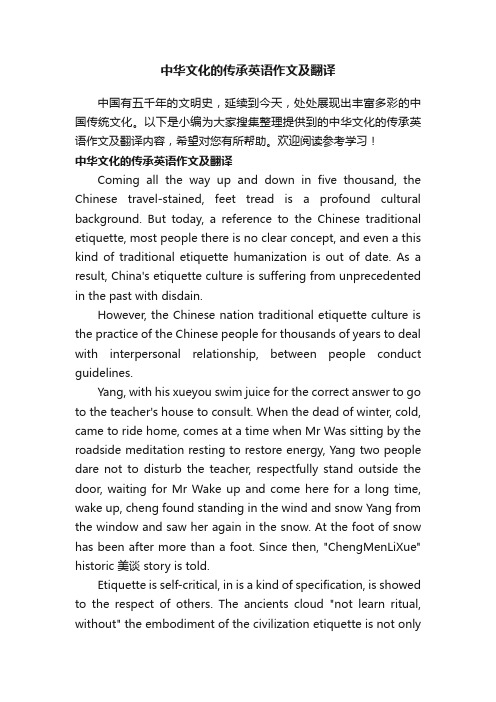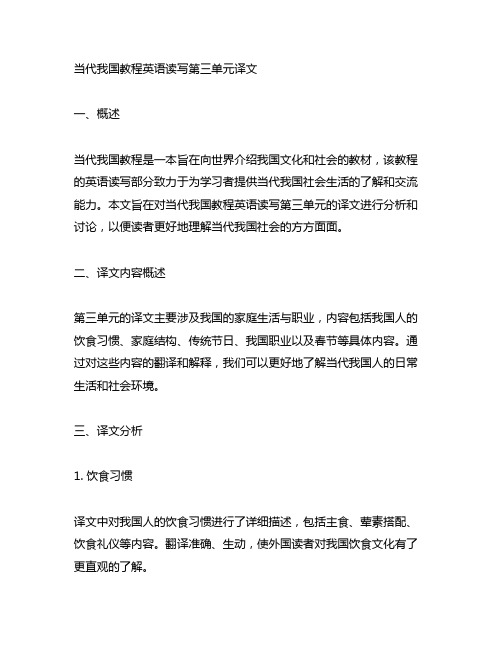读写译三中国文化
新视野大学英语第三版读写教程3课后翻译第五单元Unit 5

China is the hometown of tea and the birthplace of tea culture.
Since ancient times, tea has been known as the “national drink” of China.
In both the Chinese scholar’s seven daily necessities, namely music, chess, calligraphy, painting, poetry, wine and tea and common people’s seven ones, namely firewood, rice, oil, salt, soy sauce, vinegar and tea, tea is listed as one of the necessities.
With the development of cultural exchange, commerce and trade between China and other countries, Chinese tea and tea culture spread to the world.
Today, a number of countries across the five continents grow tea plants, and many countries import tea from China.
Chinese tea, like Chinese silk and chinaware, has become synonymous with China in the world.
中国是茶的故乡,也是茶文化的发源地。自古以来, 茶就被誉为中华民族的“国饮”。无论是文人墨客 生活中的“琴棋书画诗酒茶”,还是平民百姓生活 中的“柴米油盐酱醋茶”,茶都是必备品。同时, 中国又是文明古国,礼仪之邦。凡是来了客人或朋 友,沏茶、敬茶的礼仪必不可少。随着中外文化交 流和商业贸易的发展,中国茶及茶文化传向了全世 界。现在五大洲有不少国家种茶。也有很多国家从 中国进口茶。中国茶和中国的丝绸及瓷器一样,已 经成为中国在全世界的代名词。
大学英语读写教程4中华文明翻译

大学英语读写教程4中华文明翻译中华文明曾对世界文明产生过重大影响。
近年来,随着我国经济的发展和国际地位的提升,历史悠久的中国文化正引起世界新的关注。
越来越多的中国元素为当今世界时尚、文学、影视作品等提供了创作灵感,成为热门题材。
这一现象表明,世界需要中国文化。
在这种背景下,我国决定实施文化”走出去”的战略,以加强中国与世界其他各国的文化交流。
经过数年的努力,这项工程已经取得了很大成绩。
文化”走出去”大力推动了我国文化产业的发展,正成为提升我国国家形象和综合实力的有效途径。
Chinese civilization once had a significant influence on world civilization。
With the development of our country's economy and the rise of her international status in recent years,Chinese culture,which has a long history,is once again attracting global attention。
More and more Chinese cultural elements provide inspiration for and become popular subjects of fashions,literature and movies around the world。
This shows that the world needs Chinese culture。
It was in this context that China decided to implement the"Culture Exporting"strategy so as to enhance her cultural exchanges with the rest of the world。
中华文化的传承英语作文及翻译

中华文化的传承英语作文及翻译中国有五千年的文明史,延续到今天,处处展现出丰富多彩的中国传统文化。
以下是小编为大家搜集整理提供到的中华文化的传承英语作文及翻译内容,希望对您有所帮助。
欢迎阅读参考学习!中华文化的传承英语作文及翻译Coming all the way up and down in five thousand, the Chinese travel-stained, feet tread is a profound cultural background. But today, a reference to the Chinese traditional etiquette, most people there is no clear concept, and even a this kind of traditional etiquette humanization is out of date. As a result, China's etiquette culture is suffering from unprecedented in the past with disdain.However, the Chinese nation traditional etiquette culture is the practice of the Chinese people for thousands of years to deal with interpersonal relationship, between people conduct guidelines.Yang, with his xueyou swim juice for the correct answer to go to the teacher's house to consult. When the dead of winter, cold, came to ride home, comes at a time when Mr Was sitting by the roadside meditation resting to restore energy, Yang two people dare not to disturb the teacher, respectfully stand outside the door, waiting for Mr Wake up and come here for a long time, wake up, cheng found standing in the wind and snow Yang from the window and saw her again in the snow. At the foot of snow has been after more than a foot. Since then, "ChengMenLiXue" historic 美谈 story is told.Etiquette is self-critical, in is a kind of specification, is showed to the respect of others. The ancients cloud "not learn ritual, without" the embodiment of the civilization etiquette is not onlya man quality, breeding, also is personal morals and embodiment of social ethics.The eastern han dynasty huang-xiang just nine years old, he know aged respected, filial piety. Cold in the winter, then parents on one's own body after the quilt warm, peaceful to please their parents; In the hot summer, to the parents with a fan fan cool drive midge, to serve parents and peaceful. Huang-xiang seat is in the etiquette of the Chinese traditional filial piety, filial piety, starts from the minor matter.Over the past century, due to various reasons, some good ethics have been varying degrees of damage. People now have more abundant than in the past to filial piety economic foundation, the heart is gone, his father not overwhelmed, but powerful unintentionally.The tang dynasty years, wl back to nylon China datang FanGuo, once, back to the nylon countries to show friendly to the datang, sent messengers with a treasure see tangwangshan, one of the most precious is the white swan. On the way, white swan not careful to fly away, the messenger just plucked a few root goose feather, but failed to seize the white swan, angel in fear of goose feather is dedicated to the emperor taizong, tang dynasty didn't blame him, but felt that he is so honest that, from now on, "thousands of miles to send goose feather, courtesy light affective heavy" story to spread.Chinese traditional etiquette, should be reflect the life style of spiritual value, the record it can make our formalization.Traditional etiquette is spread for thousands of years of Chinese blood, if clogged arteries, China can only be called is a modern country, and not as China. Extensive and profound Chinese traditional etiquette culture, it is enough to makeChinese and overseas people attract RongYao and proud, it is important the cohesion of the Chinese nation, without it, people will get lost; Without it, China was only an empty shell.Throughout ancient and modern development of China and other countries, there is no loss of denying yourself a nation traditional etiquette, there is no one would think that their own excellent traditional etiquette is outdated, harmful. And spread the Chinese traditional etiquette culture. Is each Chinese children's responsibility, only in this way, we can clear conscience to loudly say: "I am a Chinese!"参考翻译:上下五千年,中国一路风尘仆仆走来,脚下踏的是深厚的文化底蕴。
口译:中国文化

1.C hinese Cuisine 中国菜Which cuisine do you like best, Sichuan, Guangdong or Shanghai?你喜欢哪种风味的菜肴,四川的,广东的还是上海的?Cantonese cuisine is popular for its special color, aroma, appearance and taste.粤菜以其独特的色、香、形、味而广受欢迎。
Can you take this numbing taste?你能吃这些麻辣烫吗?Because today is your birthday, I’ve prepared long noodles for you.今天是你的生日,我特意为你准备了长寿面。
Chinese food enjoys a high reputation around the world due to its exquisite taste and charming appearance.中国菜以精美可口而享誉世界。
To cook Chinese food, knifing skills and matching of ingredients are of equal importance.做中国菜时,刀工和菜式的搭配显得尤为重要。
Not a few Shanghai people have a sweet tooth.不少上海人钟情于甜食。
Can you use chopsticks to pick up these peanuts?你能用筷子夹起这些花生吗?2.Fengshui 风水Fengshui is actually a very complex art related to the law of nature and the universe.风水是有关自然与宇宙的一门非常复杂的艺术。
Fengshui is often considered when decorating a house.装修房子时,人们常常考虑风水的问题。
第三单元传统文化英语作文

第三单元传统文化英语作文英文回答:Traditional culture is the customs, beliefs, and practices of a particular group of people. It is passed down from generation to generation and is often deeply embedded in the fabric of society. Traditional culture can include things like language, food, religion, clothing, and music.There are many benefits to preserving traditional culture. For example, traditional culture can:Promote social cohesion and harmony.Provide a sense of identity and belonging.Enhance creativity and innovation.Promote economic development.Protect the environment.UNESCO defines intangible cultural heritage as "the practices, representations, expressions, knowledge, skills as well as the instruments, objects, artefacts and cultural spaces associated therewith that communities, groups and, in some cases, individuals recognize as part of their cultural heritage."China has a rich and diverse traditional culture. Chinese traditional culture includes things like:Confucianism.Taoism.Buddhism.Chinese calligraphy.Chinese painting.Chinese opera.Chinese martial arts.Chinese cuisine.The Chinese government has taken steps to preserve and promote traditional Chinese culture. For example, the government has established the Ministry of Culture and Tourism, which is responsible for protecting and promoting China's cultural heritage. The government has also established a number of UNESCO World Heritage Sites in China, which are places of cultural importance.中文回答:传统文化是指特定人群的习俗、信仰和实践。
中国文化翻译练习10篇(讲义)

1、中国酒文化Chinese Wine Culture中国人在7000年以前就开始用谷物酿酒。
总的来说,不管是古代还是现代,酒都和中国文化息息相关。
长久以来,中国的酒文化在人们生活中一直扮演着重要的角色。
我们的祖先在写诗时以酒助兴,在宴会中和亲朋好友敬酒。
作为一种文化形式,酒文化也是普通百姓生活中不可分割的部分,比如生日宴会、送别晚宴、婚礼庆典等。
(1)中国人在7000年以前就开始用谷物酿酒。
Chinese people began to make wine with grains seven thousand years ago.(2)总的来说,不管是古代还是现代,酒都和中国文化息息相关。
Generally speaking, wine has a close connection with Chinese culture in both ancient and modern times. (3)长久以来,中国的酒文化在人们生活中一直扮演着重要的角色。
Chinese wine culture has been play ing a quite important role in Chinese people’s life for a long time. (4)我们的祖先在写诗时以酒助兴,在宴会中和亲朋好友敬酒。
Our Chinese ancestors used to enjoy themselves bydrinking wine while writing poetry, or to make a toast to their relatives and friends during a feast.(5)作为一种文化形式,酒文化也是普通百姓生活中不可分割的部分,比如生日宴会、送别晚宴、婚礼庆典等。
Wine culture, as a kind of culture form, is also an inseparable part in the life of ordinary Chinese people such as birthday party, farewell dinner, wedding, etc. 2、中国书法Chinese Calligraphy中国书法历史悠久,它不仅是汉字的传统书写形式,也是体现自我修养和自我表达的艺术。
读写译4中国文化部分中英互译

Unit 1 Book 4剪纸剪纸又叫刻纸,窗花或剪画。
剪纸在纸的发明之前就已经流行,当时人们运用金箔,绢帛,皮革等片状材料,通过镂空雕刻的技法制成工艺品。
汉代(前206-公元220),纸张的发明促使了剪纸的发展与普及。
民间剪纸的题材多来源于现实生活,充满纳福迎祥的主题,表达对美好生活的向往。
Paper cutting (otherwise known as jianzhi) is also called kezhi, chua nghua or jianhua. Paper cutting was popular even before paper was in vented. When there was no paper, people carved on gold leaf, silk , feathers , and so on, with a carving technique known as hollow-c utting to make handicrafts. In the Han Dynasty(206BC-220AD), the inven tion of paper promoted the development and popularity of paper-cutting . The folk themes of the paper-cutting are rooted in real life, fil led with the themes of enjoying a life of ease and comfort, and ex pressing the desire for a happy life.Unit 2 Book 4儒家思想儒家思想也称为儒学,由春秋(前770-前476)末期伟大的思想家、教育家孔子所创立。
历代代表人物有孟子、董仲舒、朱熹、王阳明等。
理解当代中国教程英语读写第三单元译文

当代我国教程英语读写第三单元译文一、概述当代我国教程是一本旨在向世界介绍我国文化和社会的教材,该教程的英语读写部分致力于为学习者提供当代我国社会生活的了解和交流能力。
本文旨在对当代我国教程英语读写第三单元的译文进行分析和讨论,以便读者更好地理解当代我国社会的方方面面。
二、译文内容概述第三单元的译文主要涉及我国的家庭生活与职业,内容包括我国人的饮食习惯、家庭结构、传统节日、我国职业以及春节等具体内容。
通过对这些内容的翻译和解释,我们可以更好地了解当代我国人的日常生活和社会环境。
三、译文分析1. 饮食习惯译文中对我国人的饮食习惯进行了详细描述,包括主食、荤素搭配、饮食礼仪等内容。
翻译准确、生动,使外国读者对我国饮食文化有了更直观的了解。
2. 家庭结构译文对我国的家庭结构进行了介绍,包括父母与子女的关系、家庭聚会、家庭作风等方面。
翻译流畅自然,符合英语表达习惯,让读者能够深入了解我国家庭生活。
3. 传统节日译文对我国的传统节日进行了介绍,包括春节、中秋节等。
通过详细描述节日的庆祝方式和习俗,使外国读者能够感受到我国传统节日的独特魅力。
4. 我国职业译文对我国的职业进行了介绍,包括医生、教师、工人等。
通过对不同职业的描述,让读者了解到我国的职业结构和就业现状。
5. 春节译文对我国的春节进行了详细描述,包括习俗、庆祝方式等。
通过生动的语言和具体的描述,使外国读者能够身临其境地感受我国春节的热闹气氛。
四、结论通过对当代我国教程英语读写第三单元译文的分析,我们可以看出译文内容丰富、准确,语言流畅自然,符合英语表达习惯。
译文通过对我国家庭生活、饮食文化、传统节日和职业等方面的介绍,使外国读者更好地了解当代我国社会的方方面面。
希望本文的分析能够为读者提供更好地理解当代我国社会的途径,并对相关研究提供一定的借鉴和启发。
以上内容为对当代我国教程英语读写第三单元译文的分析和讨论,希望对读者有所帮助。
很抱歉,但我似乎误解了你的需求。
- 1、下载文档前请自行甄别文档内容的完整性,平台不提供额外的编辑、内容补充、找答案等附加服务。
- 2、"仅部分预览"的文档,不可在线预览部分如存在完整性等问题,可反馈申请退款(可完整预览的文档不适用该条件!)。
- 3、如文档侵犯您的权益,请联系客服反馈,我们会尽快为您处理(人工客服工作时间:9:00-18:30)。
新时代交互英语读写译三UNIT1中国传统节日中国传统节日以中国的农历为依据。
农历年的岁首称为春节,俗称“过年”,有祈年等多种习俗,是中国人民最隆重的传统节日,象征团结兴旺。
其他主要的节日有元宵节、清明节、端午节、七夕节、中秋节、重阳节、冬至节、腊八节等等。
各个节日都有其来源讲究和风俗习惯。
农历节日与农历中的二十四节气不同。
农历节日是中华民族凝聚力和生命力的体现。
Traditional Chinese FestivalsTraditional Chinese festivals are usually fixed according to the Lunar calendar. January 1st on lunar calendar has been designated as the Spring Festival (generally referred to as guonian). There are several customs during the Spring Festival, such as praying for a good harvest, etc. The Spring Festival is the most ceremonious traditional festival in China and symbolizes unity and prosperity.Some other significant Chinese festivals include the Lantern Festival, the Pure Bright Festival, the Dragon Boat Festival, the Double-seventh Festival, the Mid-Autumn Festival, the Double-Ninth Festival, the Winter Solstice, and the Eighth Day of the Twelfth Lunar Month, etc.Each festival has its own unique origin and custom.These Chinese festivals that follow the Lunar calendar are different from the 24 Solar Terms in the Lunar calendar. They embody China’s cohesion and vitality.UNIT2中国茶文化茶是中华民族的举国之饮,发端于神农,兴盛于唐宋(618—1279)。
开门七件事,柴米油盐酱醋茶,是中国人日常生活的写照。
茶文化是茶的自然和人文双重属性的引申与概括。
中国的茶道精神将儒释道三教融入其中,其主要目的是借助饮茶艺术来修炼身心,体悟大道,提升人生境界。
Chinese Tea CultureAs a traditional drink for Chinese people, Chinese tea is believed to have first started with Chinese Emperor Shen Nong, and flourished in the Tang and Song Dynasties (618AD-1279AD).Making tea was considered one of the seven basic daily necessities along with fuel, rice, oil, salt, soy sauce and vinegar, while drinking tea is an apt portrayal of daily life in China.Tea culture is the extension and generalization of the science and the humanities character of tea.In China, the tea spirit blends the thoughts of Confucianism, Buddhism and Taoism, and it aims to help people cultivate both mind and body, comprehend the truth, and elevate the realm of life through the art of drinking tea.UNIT3中国画中国古代四大艺术“琴棋书画”的“画”特指中国画。
其绘画形式是用毛笔蘸水、墨、颜料作画于绢、帛、宣纸之上,古代称之为水墨丹青。
为区别于西方的油画而称之为“中国画”,简称“国画”。
其题材有人物、山水、花鸟等。
技法可分为工笔和写意。
国画的艺术特质在于“笔墨”,强调以形写神,画尽意在。
国画在艺术创作上反映了中华民族的审美意识和情趣。
Traditional Chinse PanitingThe four art forms in ancient China are guqin, chess, penmanship, and painting. And paintingparticularly refers to traditional Chinese painting.Traditional Chinese painting is done with a brush dipped into black or colored ink and is painted on silk or xuan paper. In ancient China, it was called “ink-painting”. In order to distinguish it from Western oil-paintings, the Chinese people term their works “traditional Chinese painting” (abbreviated to “Chinese painting”).The subject matters of Chinese paintings are typically figures, landscapes, birds and flowers. The drawing skills and techniques employed by the Chinese painters can be divided into two forms: fine brushwork and free-hand brushwork.The artistic characteristics lie in “the writing brush and ink”. Chinese painting emphasizes using the shape to convey the feelings of the painter. Even though a painting is a finished product, it endlessly conveys a meaning. In terms of the artistic creation, traditional Chinese painting is a reflection of the aesthetic consciousness and artistic sentiment of the Chinese people.UNIT4中国酒文化中国是酒的故乡。
古人将酒的作用归纳为治病、养生、礼仪三类。
酒文化是中华饮食文化的重要组成部分,它的精神文化价值体现在社会政治生活、文学艺术乃至人生态度、审美情趣等诸多方面。
无酒不成宴,酒筹文化是中国合餐制的产物。
宴席上的酒令五花八门,猜拳、文字令、筹令等都富有丰厚的文化内涵,若胸中无数,则难以自如应对。
Chinese Wine and Spirits CultureChina is the home of wine and spirits. The functions of wine and spirits were classified by the ancients into three kinds: treating patients, keeping in good health, and showing politeness and respect to others. China’s wine and spirits culture is an important part of Chinese food culture, and it embodies its values in many aspects, such as in social and political life, literature and art, life philosophies, aesthetics and so on. There is an old saying which goes, “It is not a banquet without wine”. Under the custom of having dinner together in China, drinking games were therefore introduced. There are many kinds of banquet betting and drinking games, like morra (a finger-guessing game) , wine/spirits words, wine/spirits chips (a drinking game), all with rich cultural connotations. In reality, it is difficult to win unless you have a card up your sleeve.UNIT5中国石窟中国石窟主要反映的是佛教文化艺术。
敦煌莫高窟、大同云冈石窟、洛阳龙门石窟、天水麦积山石窟,号称中国四大石窟艺术景观。
佛教石窟随山雕凿、彩绘,形象生动自然,将崇高美与世俗情融为一体,把天然造化与人工创造有机结合,是由建筑、绘画、雕塑等组成的博大精深、绚丽夺目的综合艺术殿堂。
